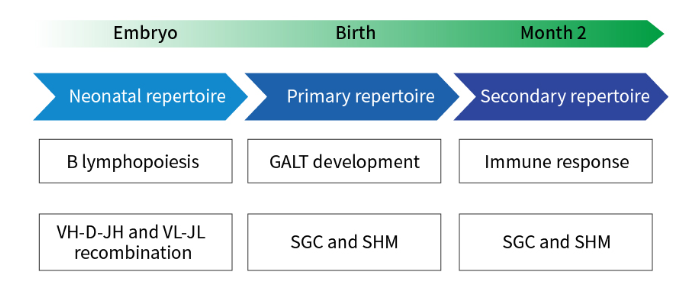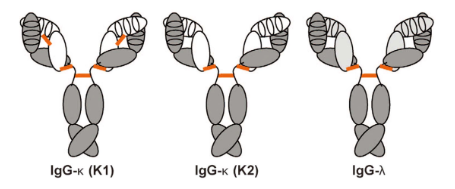Rabbit Monoclonal Antibody for Detection - Higher Performance & Higher Sensitivity
Rabbit Monoclonal Antibody for Detection
Antibodies are the most commonly used tools in biological research. They are used in various assays such as Western Blot (WB), immunoprecipitation (IP), immunofluorescence (IF), immunohistochemistry (IHC) and ELISA. The two most common hosts that produce monoclonal antibodies for detection are rabbits and mice. Rabbit monoclonal antibodies for detection have the following advantages over murine monoclonal antibodies.
Antigen Recognition and Antibody Repertoire Diversity
First, rabbits, as hosts, recognize more antigenic epitopes and produce a greater variety of antibodies than mice. Rabbits have larger spleens and other immune organs than mice and can produce more lymphocytes (B cells), corresponding to more antibodies. Second, in mice, antigens such as small molecules and peptides are usually with low immunogenicity, while rabbits can also generate an immune response to these low immunogenicity antigens. Moreover, high mutations in somatic cell gene conversion and variable regions affecting immunoglobulin (Ig) genes were more common in rabbits than in rodents. This ultimately contributes to the expansion of the rabbit monoclonal antibody library. Thus, the resulting rabbit antiserum will contain a greater variety of antibodies compared to the mouse antiserum, which means there is a greater chance of finding the ideal clone for amplification.

Figure 1. Rabbit B-cell and antibody library development
In addition, the Immunodominance is low in rabbits, so that antibodies produced in rabbits typically recognize more epitopes than those produced in mice. Immunodominance refers to the fact that specific epitopes are more immunogenic than other epitopes of the same antigen, which results in the immune system producing antibodies primarily against immunogenically dominant epitopes. The immune system of rabbits is less immunodominant than the immune system of mice, which allows for a broader range of detected epitopes and a higher likelihood of finding unique epitopes when developing rabbit monoclonal antibodies.
Affinity and Specificity
In general, rabbit monoclonal antibodies are similar to traditional mouse monoclonal antibodies, but have better affinity and specificity. After performing immunization, rabbit monoclonal antibodies have a longer affinity maturation time than mice, resulting in higher affinity and specificity. Rabbit monoclonal antibodies also recognize minor epitope variants and cleaved target proteins more effectively.
The rabbit monoclonal antibody has a higher affinity, compared to the murine monoclonal antibody, it can not only affinity with the antigen in the nanomolar range, it can even reach the picomolar level (KD = 10-12M) with a higher sensitivity .

Figure 2. Comparison of affinity of mouse and rabbit antibodies
In terms of detection, since rabbit monoclonal antibodies detect more refined epitopes, there is less chance of cross-reaction with other proteins. At the same time, rabbit monoclonal antibodies bind to target antigens with higher affinity, which means that researchers can perform molecular assays with smaller amounts of antibody and therefore have a higher signal-to-noise ratio compared to mouse monoclonal antibodies.
Immunoglobulin Structure
Rabbits have more IgG as isotype control, while mice have a higher proportion of IgM. Rabbits are more likely to produce specific antibodies due to the better specificity of IgG than IgM. At the same time, the CDR3 loop (third complementary determining region) of the rabbit light chain is significantly longer compared to humans and mice. This property may also contribute to the increased binding capacity of rabbit monoclonal antibodies. In addition, rabbit IgG generally has fewer amino acid residues at the N-terminal and D-E loops. These biomolecules also have unusual structural inter-domain disulfide bonds that may play a critical role in increasing the stability of these molecules and in extending shelf life.

Figure 3. Diagram of natural rabbit IgG
Conclusion
Monoclonal antibodies have traditionally been generated in rodents (e.g., mice) because it is cost effective and easier to administer. However, the immune system of rabbits is capable of producing a broader range of high-affinity antibodies compared to mice, making rabbits an increasingly preferred host species for monoclonal antibodies in a wide range of research, diagnostic and clinical applications. Rabbit monoclonal antibodies can better recognize subtle differences (e.g., epitope variants such as modifications, mutations, conformational changes), detect a broader range of antigens such as small molecules and peptides, and recognize multiple epitopes for each target antigen. Most importantly, rabbit monoclonal antibodies respond better to immunogens and have a higher affinity and specificity for epitopes. Moreover, the experimental results of murine monoclonal antibodies may be confounded by the HAMA effect, which is not the case for rabbit monoclonal antibodies. In the direction of detection, rabbit monoclonal antibody is more sensitive, has lower limit of detection and requires lower sample concentration compared to murine monoclonal antibody.
Reference
1.Feng L, Wang X, Jin H. Rabbit monoclonal antibody: potential application in cancer therapy. American Journal of Translational Research. 2011;3(3):269 .
2.Justus Weber, Haiyong Peng, Christoph Rader. From rabbit antibody repertoires to rabbit monoclonal antibodies. Experimental & Molecular Medicine 2017 (49)
3.Rossi, S. et al. Rabbit monoclonal antibodies: a comparative study between a novel category of immunoreagents and the corresponding mouse monoclonal Am J Clin Pathol. 2005 Aug;124(2):295-302. doi: 10.1309/NR8HN08GDPVEMU08
4.Vilches-Moure, J.G. and Ramos-Vara, J.A., 2005. Comparison of rabbit monoclonal and mouse monoclonal antibodies in immunohistochemistry in canine Journal of veterinary diagnostic investigation, 17(4), pp.346-350.
5.Weber, J. et al. From rabbit antibody repertoires to rabbit monoclonal antibodies. Exp Mol Med. 2017; 49(3): e305. doi: 10.1038/emm.2017.23






